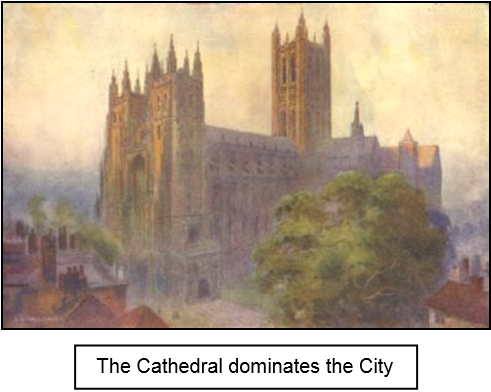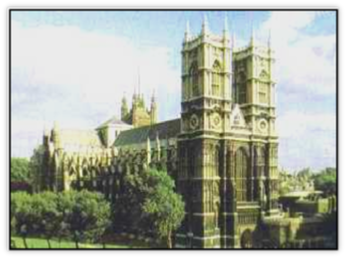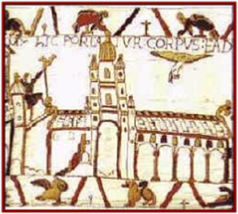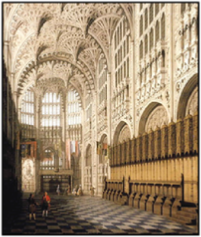


CANTERBURY CATHEDRAL 1503 (H7)
Including:
Westminster Abbey
and Henry VII’s Chapel

xxxxxCanterbury was the site where King Ethelbert welcomed St. Augustine at the start of his mission in 597. The city has been the centre of the Anglican Church ever since, and the seat of the Archbishop of Canterbury, leader of the Church. The name derives from the old English Cantwarabyrig -
 xxxxxAs we have seen, work on the present-
xxxxxAs we have seen, work on the present-
xxxxxThe early work on the cathedral was begun by the French master mason William of Sens following a fire in 1174, but he was injured when falling from some scaffolding and the work was continued by “William the Englishman”. The choir is of the Romanesque period, and some of the stained glass in the choir and sanctuary dates from the latter part of the 12th century and is regarded as the finest in England. The great tower, known as Bell Harry, was built at the end of the 15th century, during the final stages of the construction. Henry IV and the Black Prince are buried in the cathedral.
xxxxxIncidentally, at the end of the 16th century the large crypt below the cathedral was granted to Huguenot refugees, French Protestants, who had been forced to leave their country because of religious persecution. To this day a service in French is held there once a week.
 xxxxxWestminster Abbey,
xxxxxWestminster Abbey,  one of Britain’s most important historical buildings, contains the shrine of Edward the Confessor, tombs and memorials of famous British subjects -
one of Britain’s most important historical buildings, contains the shrine of Edward the Confessor, tombs and memorials of famous British subjects -
xxxxxIn 1503 Henry ordered the construction of a large chapel in Westminster Abbey. Built on the site of an earlier Lady Chapel, the Henry VII Chapel (illustrated) is a fine example of Late Gothic architecture with its fine tracery and the delicate design of its fan-
xxxxxIncidentally, Westminster Abbey -
xxxxxIt was at Canterbury that King Ethelbert welcomed St. Augustine at the start of his mission in 597. Since then the city has been the centre of the Anglican Church and home to its leader. Foundations were laid in the reign of William I, and the first stage was completed in 1503, with architectural styles ranging from the Romanesque to the Perpendicular. Following the murder of Thomas Becket on the altar steps in 1170 (H2), his tomb became a shrine, but this was destroyed during the Reformation. Some of the stained glass dates from the late 12th century, and is amongst the finest in England. The great tower (Bell Harry) was built at the end of the 15th century. Henry IV and the Black Prince are buried in the cathedral.



Acknowledgements
Canterbury: watercolour by the English artist Ernest Haslehust (1866-
H7-